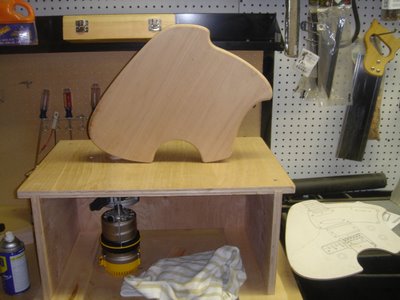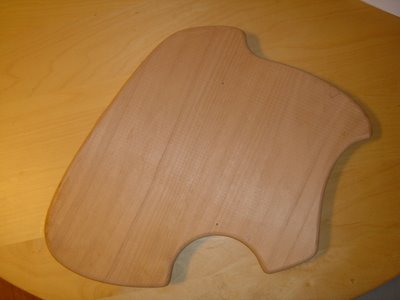Guitar Body Flush Trimmed and Rounded Over

Here is the latest on my guitar build – the guitar body is flush trimmed and I’ve radiused all the edges with a 5/16″ round over bit. The body sits on my homemade router table with the DEWALT 2.25 hp Router under it. Here is a closeup of the guitar body:

Tools
Here is the list of tools I used:
- 2″ cut length flush trim bit I could have used a pattern bit but with the bearing on the bottom rather than the top, I didn’t feel it was as safe as a flush trim bit. The flush trim bit only exposes as much of the cutting edge as is necessary unlike the pattern bit which exposes the entire cutting surface. I purchased the bit from MLCS.
- DEWALT 2.25 hp Router – The quality is excellent, the height adjustment mechanism is smooth and installing router bits is fast and simple.
- Router table – I decided to build my own and I’m glad I did. Not only was it inexpensive to build but it is very solid (unlike the cheaper bench top models on the market) and it gave me another opportunity to work with the router. The materials list is very simple. It includes a 2×4 sheet of oak veneered plywood, a handful of drywall screws and plain pine for the feet to provide a clamping surface. The whole thing cost just a few dollars.
- Safety goggles or glasses – This is imperative. Routers bits spin at tens of thousands of RPM’s. A bit that catches can send a dangerous piece of debris toward your eyes.
- Respirator – The whole process kicks up a TREMENDOUS amount of wood dust and chips. Protect your lungs.
- Vacuum – The vacuum not only picks up some of the heavier debris, it reduces the amount of airborne dust.
Safety
As a beginning woodworker, I thought long and hard about safety and came up with the following for myself:
- Don’t work with the router unless you are focused on the work – That means being alert and working in an environment devoid of distractions.
- Always be conscious of where your hands are relative to the cutting surface – It doesn’t take much to end up with mangled hands.
- Always maintain visibility – Stop frequently to clear away dust and chips.
- Disconnect the router whenever it’s not in use – stopping to clear away debris, stepping away, examining progress, changing bits etc.
To improve safety, I will be adding a fence with a dust collection port and a guard over the bit.
The Process
Here was my “script” for working on this phase of the guitar build:
- Screw the template to the body – Locate the screws where the holes will be hidden or routed away. I chose a future pick up position and the future bridge route position.
- Make sure the router mount is solid – Vibration will loosen the screws holding it. Check it before starting any work. Besides issues of safety, it ensures an accurate cut.
- Set the router bit to the appropriate height.
- Put on eye protection.
- Put on the respirator.
- Plug in the router.
- Start the router.
- Route from right to left, smoothly and steadily taking off small amounts at a time – do not put excessive pressure on the piece to push it into the router bit. Allow it to do its job.
While flush trimming, I had an accident on the upper bout. The cutting edge caught the body, tearing out a chunk and fracturing a section of the edge over a span of about 2″. Fortunately, I was able to repair this with hide glue and a well-placed clamp. Once it dried, I used wood filler to fill in gaps. The repair restored the lines of the design. If this hadn’t worked, plan B was to slice off the damaged section, glue on a piece from the left over scrap and re-work the area. The only visible sign on the face of the guitar body is a glue stain.
All in all, I’m very happy with the results. It’s actually starting to look like a guitar.
My next steps are the neck and pickguard. Coming into this phase of the project, I had considered purchasing a low end Steinberger and using its neck. However, I’m encouraged by my success to date so I will attempt to build one instead. As far as the pickguard, I don’t care for the original design so I will design my own. Stay tuned.
More on my first guitar project:
Are you not carving the chamfer on the bottom left and back?
PJ – The forearm cut and belly contour will come a bit later. I will route the neck pocket and bridge cavity first. Since these are critical, I want to keep the body flat for this step.